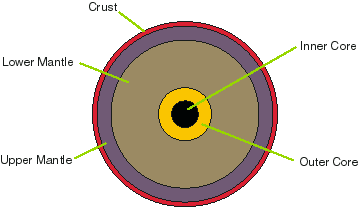But how can the poles shift?
Rather than the Earth being a solid piece of rock, it is divided into distinct layers. We live on the outer surface of the crust, which is broken up into six main continental plates and a few smaller ones. Geologists have differing opinions on what is further below, but for our purposes this simplified model will suffice:
 |
The inner core consists of solid iron and is surrounded by an outer core of liquid iron. The lower mantle is made of molten rock. The upper mantle and crust are solid, but only loosely connected and are able to slip and slide against each other, the least effect of which is continental drift. All layers are capable of independent movement.
Directly below the Earth’s crust (or lithosphere) at a depth of 50-150 kilometres is a layer called the asthenosphere. It is constructed of a low-velocity plastic material capable of flow. The crust is split into plates, and the tectonic plate theory says that these plates move individually, slipping over the hot semi-plastic asthenosphere, at a rate of 1-4 cms a year. The action of these plates pushing against each other causes mountain ranges to form, causes earthquakes and stimulates volcanic activity.
Apart from being a permanent constant (orthodox gradualist view), this movement of a miniscule 1-4 cms a year could also be the low point in a fluctuating system, or the crust’s momentum finally coming to a halt after a major slippage of 30 degrees, which occurred in recent times – perhaps 12,000 years ago.
There are two ways in which the location of the poles might shift:
1. Poleshift: A sudden and radical displacement of the planet’s axis of rotation (the earth tips over).
-or-
2. Poleshift: A slippage of the planet’s solid crust over the molten interior – so that the polar locations change.[6]
Entire planet tipping over
The layers of the Earth remain stable, and the entire planet tips over as one unit. This could either be caused by unknown extra-terrestrial forces, or the Earth somehow becoming unbalanced. A similar unbalancing event probably happened on Mars. Along its equator is a massive volcano known as Tharsis, which is the largest known gravity anomaly in our solar system. Either this volcano formed on the equator and has remained there ever since, or, more likely, it formed elsewhere and then migrated there due to centrifugal forces. If a point on a spinning globe is much heavier than average, then centrifugal forces will try to shift that point towards the equator
If this happened to Earth then it is hard to say how fast it would shift, or what level of catastrophe would occur. It could feasibly be so slow and uneventful that we wouldn’t even notice.
In 1955 Thomas Gold [7] stated that if the earth were a perfect sphere instead of a flattened spheroid, ‘the smallest beetle walking over it would be able to change the axis of rotation relative to markings on the sphere by an arbitrarily large angle; the axis of rotation in space would change by a small angle only’.
Fortunately, that cannot happen, because the earth has an equatorial bulge. This gives our planet stability, in the same way that a spinning top, which is wider in the middle, manages to stay upright as long as it keeps spinning.
Made out of solid wood, a top could happily spin forever without any harm coming to it. But if it were hollow, however, and something loose was rattling around inside, then its spinning actions would eventually cause it to wear our – friction and interaction between two objects will always eventually cause fatigue and destruction. The earth, as we saw above, is not a single solid unit – it has layers that scrape against each other.
Slippage of the crust
Charles Hapgood proposed that this slippage between the top two layers of the Earth allows for the continental plates to move as a single unit, rapidly over great distances – just as the skin of an orange, if separated from the fruit’s inner part, can move as one piece. The core remains where it is, and the axis and orbit of the planet remain unchanged. Orthodox science, fixating on the idea of gradualism, has chosen to ignore this idea. They have yet to disprove it.
The crust’s movement over the asthenosphere would create mayhem. If the current level of volcanic and earthquake activity is caused by plates shifting 1-4 cms a year, then imagine what would happen if they shifted thousands of kilometres in less time!
In 1955, just prior to his death, Albert Einstein wrote this foreword to a book on pole shifts:
I frequently receive communications from people who wish to consult me concerning their unpublished ideas. It goes without saying that these ideas are very seldom possessed of scientific validity. The very first communication, however, that I received from Mr. Hapgood electrified me. His idea is original, of great simplicity, and – if it continues
to prove itself – of great importance to everything that is related to the history of the earth’s surface.. The author has not confined himself to a simple presentation of the idea. He has also set forth, cautiously and comprehensively, the extraordinarily rich material that supports his displacement theory. I think that this rather astonishing, even fascinating, idea deserves the serious attention of anyone who concerns himself with the theory of the earth’s development.”[8]
The book is by Charles Hapgood – The Earth’s Shifting Crust (1958).
[6] John White, Pole Shift (1980), page xix
[7] T. Gold, ‘Instability of the earth’s axis of rotation’, Nature, vol. 175, 1955, pp. 526-9; Pole Shift, p. 60.
[8] Charles Hapgood, The Earth’s Shifting Crust (1958)

